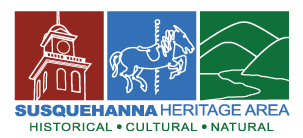The Village of Owego (https://villageofowegony.gov/) was founded in 1787 and is situated on the Susquehanna River at the western edge of the Town of Owego. The completion of the Owego- Ithaca Road in 1808 and the presence of a ferry crossing and later a bridge across the Susquehanna made Owego a prosperous trade center during the nineteenth century. Later, manufacturing and industry created more wealth, resulting in construction of elaborate new homes and commercial buildings.
In the fall of 1849, much of Owego’s business district was destroyed by a fire in which 104 buildings were lost. Between 1850 and 1890, the downtown area was rebuilt with new brick buildings, and the commercial district today reflects this construction period. Today, Owego is the second largest village in Tioga County and serves as the county seat. The Village Courthouse Square, with the 1872 Courthouse and county buildings bordering a sloping green and facing the river, forms an impressive gateway to the town center. Owego’s streets are lined with an impressive array of residences, public buildings, and churches, including numerous high-end examples of the most popular architectural styles of the nineteenth century.
Owego is the local model of success that can be achieved through a comprehensive and sustained downtown revitalization program. The Village core and surrounding neighborhoods are appealing in character. The adaptive reuse of historic buildings along several commercial streets has created a lively commercial area with a number of fine shops and restaurants. To an extent, the task of revitalization was easier in Owego than in the Triple Cities because of its smaller size and balance of commercial, manufacturing, and residential neighborhoods.
The active involvement and participation by community members has also helped to sustain the Village. The Tioga Council on the Arts, Historic Owego Marketplace, Owego Historic Preservation Commission, Historical Society, and the Tourism Office have been instrumental in the Village’s revitalization. The revitalization programs that have worked in Owego should be supported and used as a model for the revitalization of other villages within the Heritage Area. Further evidence of the success of Owego is its 2007 designation as a “Preserve America” community by the White House and its 2009 designation by Budget Travel Magazine as “America’s Coolest Small Town.”
|
|
